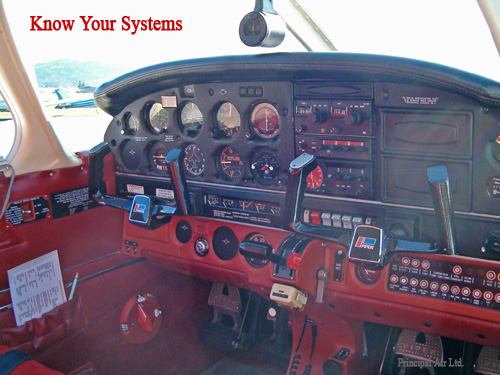
Know Your Systems
By: Alex Burton
CFI Principal Air Ltd. Chilliwack B.C.
“By three methods we may learn wisdom: First, by reflection, which is
noblest; second, by imitation, which is easiest; and third by experience,
which is the bitterest.”
--Confucius—
I
was discussing emergency procedures some time back with a person I interact
with on a regular basis. He related an interesting story. He was flying one
day and, glancing down for an instrument check, noticed decreasing airspeed.
Being a methodical, careful, alert pilot, he checked his other instruments
to see if more information would reveal the problem. RPM appeared stable as
did altitude, attitude, and vertical speed. Oil temperatures and pressures
remained in the green…. a puzzle.
The
truth, of course, emerged. First by smell, then by the appearance of smoke
from under the dash, an electrical fire revealed itself. Heated wires had
burned a small hole in the pitot tube input to the airspeed indicator,
reducing pressure and manifesting as an apparent reduction in airspeed.
Electrical malfunction would not have been my first thought given the early
symptom of airspeed loss nor was it his initial diagnosis. He did recognize
he had a problem, however, and was alert for emerging symptoms as they
revealed themselves. He was prepared for the situation when it did, finally,
make itself clear.
Sadly, emergencies do not always telegraph themselves as clearly as we might
hope; a voice does not sound in our headset saying “Electrical Fire. Follow
the Procedures in Your Emergency Checklist for Electrical Fire.”
It would be nice if that did happen; it does not.
I notice a variation on this theme fairly regularly on flight tests.
Students have worked hard to memorize the procedures on their emergency
checklists and are normally prepared to recite them accurately and at a high
rate of speed. However, unless they are given a very clear statement of the
“emergency”, for example, “You have an engine fire,” they may have
difficulties deciding which emergency procedure to employ.
I’ll give a specific example. Let’s say I am flying with a pilot candidate
and we are in an extended climb. I might say something along the lines of
“We’re in a long climb. Let’s say it’s a very warm day outside. Checking the
oil temperature gauge, we notice it is pointing to the very top of the green
or even slightly above. What should we do?”
I’ve received a variety of answers from shut the engine down and conduct a
forced landing to level off, enrich the mixture, and reduce power.
During de-briefing following the flight, I’ve worked with the candidate to
analyze the situation. What are some of the factors that might cause high
oil temperature to occur? What information can we get from the other
available instruments? What is the potential difficulty we are facing? What
are the potential remedies available to us? What might be a reasonable
remedial action? What would we expect to happen? What if what we expect to
happen doesn’t happen? What might be another line of approach?
Virtually every decision we make, both in flying and in life, is made with
partial information and limited time. We simply do not have complete
information available to us at any given moment, nor, normally, do we have
all the time and leisure available to fully investigate all aspects of a
problem prior to making a decision. We can, however, mitigate our
limitations by ensuring we have made a good effort to know and understand
what we are dealing with before we find ourselves in difficulties.
Time spent on the ground learning our aircraft’s systems is time very well
spent. Knowing how each system works, what its component parts are, where
they are, and how they function can give us considerable insight into
situations that may develop. We’ve all heard or read about the fellow who
executed a forced landing due to fuel starvation when he still had 35
gallons of fuel in the “other” tank.
Many pilots will remember the acronym DECIDE from their training:
Detect a change. Estimate the significance of the
change. Choose the outcome objective. Identify
plausible action options. Do the best action. Evaluate
the progress.
A slightly simpler four-step, circular model, as presented in Transport
Canada’s Human Factors for Aviation Basic Handbook, TP12863 (E),
is:
1. Gather Information
2. Process Information
3. Make Decisions
4. Act on Decisions
Problem-solving is a dynamic, ongoing process dependant on a number of
factors including awareness of the situation, knowledge and understanding of
available options, an ability to isolate and identify symptoms, a
willingness to make the best decision possible given what is known at a
particular moment, and the ability to evaluate the results of those actions
and apply the results of our evaluation toward further action, as required.
Knowledge and understanding are invaluable tools. It is a good thing to
memorize your emergency checklists. Please do that and keep the checklists
handy, as well. It is not, however, the end of the process.
Emergencies do not always arrive clearly labelled. Understanding, as you
might say, the etiology or origins and meanings of symptoms can increase our
ability to work more quickly to the essential problem manifesting itself and
its potential remedies.
Learning an aircraft’s systems, knowing and understanding how they work and
what might happen if they only partially function or fail to function
entirely, can be a very important addition to our ability to conduct safe
flight for ourselves, our passengers and all those others who wander the
roads and paths below looking up hoping we will not drop out of the sky on
their heads.
|

